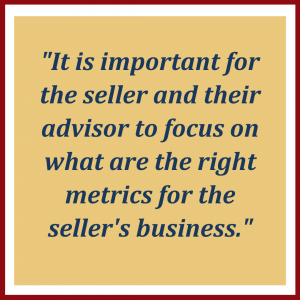In this episode, Gina Cocking and Jeff Guylay focus on valuation – determining what your company is worth.
Key takeaways from this episode are:
- The right valuation methodology depends on the industry and the company
- Valuation should not be overly focused on the multiple. It also depends on what you apply the multiple to
- Market price discovery through a competitive process will drive the highest valuation

In this episode, Colonnade Advisors addresses the following questions as related to valuation:
What are the different valuation methodologies used? (00:48)
Gina: “There are comparable company trading, comparable transaction, and the more complex discounted cash flow valuations. There are also other types of valuation methods that are not relevant to what we do on a day-to-day, so we will focus on the three main ones.”
At what point in the process is valuation analysis generally performed? (01:12)
Jeff: “It is often performed ahead of going to market. Many times, it is ahead of us doing due diligence. We might update these valuation analyses for our clients at various points throughout the process, and we do a gut check on whether we are ready to go to market.”

What is the value of hiring a sell-side financial advisor in determining the transaction price? (01:12)
Jeff: “Ultimately, it is the market that sets the transaction price. The real value of hiring a financial advisor to help sell a business is to get the best price and terms, which is generally achieved through an auction process.”
What is a comparable transaction valuation? (02:43)
Jeff: “It is what the market has offered up to companies that are comparable to the company being evaluated. For example, if a company sold at eight times EBITDA, it’s logical to assume that another company that is very similar, or comparable, would trade at eight times EBITDA.”
What attributes of a target company will impact the comparable transaction multiple? (03:37)
Jeff: “The multiple will depend on all sorts of attributes of the specific target company, whether it is growing faster or slower, whether the management team is better or worse, client concentration, or geographic concentration. All sorts of things influence the multiple that a buyer is willing to pay.”
What is comparable trading valuation, and how does it apply to middle market transactions? (04:17)
Jeff: “This involves looking at where the comparable public companies are trading in the public markets. The comparable trading valuation metrics are a little more theoretical for the middle market transactions. It is a helpful metric and something used in negotiations with buyers, but there are all sorts of factors that drive the multiple relative to what you might expect to achieve in the private market.”
Gina: “Volatility in the public market will impact the valuation of public companies. You do not see the same day to day volatility in a private transaction. For a middle market company, comparable trading valuation is less relevant because of the size differential.”
What is discounted cash flow valuation? (06:35)
Jeff: “The discounted cash flow valuation is an analysis of the businesses’ free cash flows. Then discount the cash flows at a certain discount rate to arrive at the net present value of all those cash flows. The biggest drivers of this analysis include the discount rate, which could be derived using the CAPM model, and a variety of other factors.”
What industries use revenue multiples? (09:37)
Gina: “Pre-profitability companies use revenue multiples. It is often used in high growth type businesses such as software and biotech companies and recurring revenue companies. The revenue multiples can range depending on the industry.”
What is the rationale for using EBITDA multiples? (10:29)
Gina: “EBITDA is a proxy for cash flow and normalizes income between various companies.”

How do you determine which multiple metrics to use? (11:58)
Jeff: “There are many different metrics that buyers and sellers can focus on, and it is generally industry-specific. It is important for the seller and their advisor to focus on what are the right metrics for the seller’s business.”
What are the multiple metrics applied to? (12:34)
Gina: “There are a lot of different ways to look at what the metric is. Different methods are used in different industries. Some industries use GAAP accounting, and some industries use some special purpose accounting. There are also add-backs to EBITDA so that anything unusual and extraordinary can be added back to increase EBITDA and valuation.”
What is the significance of add-backs? (14:18)
Jeff: “Add-backs help demonstrate what the company’s earnings stream looks like going forward. It gives a sense of the pure earnings of the business.”
What are pro forma adjustments to EBITDA? (14:58)
Gina: “It involves adjusting historical EBITDA for known future or recent arrangements, such as a decrease in expense or increase in operating efficiency. The adjusted EBITDA demonstrates how the business is going to operate going forward.”
What is synergy in an M&A transaction, and can the seller benefit? (17:13)
Gina: “Synergy is when two companies combine, and instead of being one plus one equals two, one plus one equals three. That could be because of expense reductions or revenue enhancements. Buyers will benefit from synergies in the future. A competitive process will increase the likelihood that a seller will get paid for at least a portion of the synergies a buyer may achieve.”
How does customer concentration impact valuation? (19:26)
Gina: “Customer concentration or any distribution channel concentration will typically reduce valuation. Customer concentration involves anything greater than 15%.”

How does the transaction process impact the price and term? (20:49)
Jeff: “There are various factors that could lead to a potential buyer dropping out. Therefore, finding the greatest number of highly qualified buyers and working diligently through the process delivers the best price and term for sellers.”
What is the difference between enterprise value versus equity value? (21:47)
Gina: “If a company has debt on the books, then the debt is subtracted from the enterprise value to get to the equity value.”

What is the ultimate answer to “What is my company worth?” (23:30)
Gina: “Your company is worth whatever someone is willing to pay for it. Our job is to create a competitive environment to yield the highest price and the best terms.”





